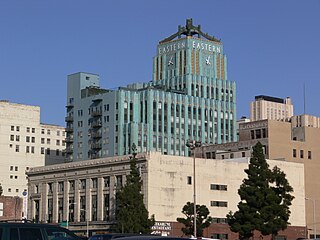
The Historic Core is a district within Downtown Los Angeles that includes the world's largest concentration of movie palaces, former large department stores, and office towers, all built chiefly between 1907 and 1931. Within it lie the Broadway Theater District and the Spring Street historic financial district, and in its west it overlaps with the Jewelry District and in its east with Skid Row.

Broadway, until 1890 Fort Street, is a thoroughfare in Los Angeles County, California, United States. The portion of Broadway from 3rd to 9th streets, in the Historic Core of Downtown Los Angeles, was the city's main commercial street from the 1910s until World War II, and is the location of the Broadway Theater and Commercial District, the first and largest historic theater district listed on the National Register of Historic Places (NRHP). With twelve movie palaces located along a six-block stretch of Broadway, it is the only large concentration of movie palaces left in the United States.

Downtown Long Beach is the heart of Long Beach, California, United States. It is the location for most of the city's major tourist attractions and municipal services, and for numerous businesses. There are many hotels and restaurants in the area that serve locals, tourists, and convention visitors.
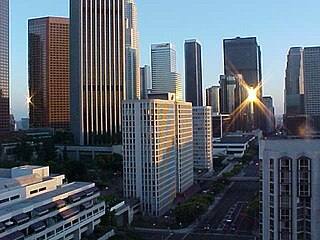
The Financial District is the central business district of Los Angeles along Olive, Grand, Hope, Flower and Figueroa streets from 4th Street to 8th Street. It is south of the Bunker Hill district, west of the Historic Core, north of South Park and east of the Harbor Freeway and Central City West. Like Bunker Hill, the Financial District is home to corporate office skyscrapers, hotels and related services as well as banks, law firms, and real estate companies. However, unlike Bunker Hill which was razed and now consists of buildings constructed since the 1960s, it contains large buildings from the early 20th century, particularly along Seventh Street, once the city's upscale shopping street; the area also attracts visitors as the 7th and Flower area is at the center of the regional Metro rail system and is replete with restaurants, bars, and shopping at two urban malls.

The Culver Hotel is a national historical landmark in downtown Culver City, California. It was built by Harry Culver, the founder of Culver City, and opened on September 4, 1924, with local headlines announcing: "City packed with visitors for opening of Culver skyscraper." Originally named Hotel Hunt, and later known as Culver City Hotel, the six-story Renaissance Revival building was designed by Curlett & Beelman, the architecture firm behind renowned Art Deco buildings throughout Los Angeles, including downtown Los Angeles's Roosevelt and Eastern Columbia buildings.

The F. Q. Story Neighborhood Historic District is located in central Phoenix, Arizona, United States. The neighborhood runs from McDowell Road south to Roosevelt Street and from Seventh Avenue west to Grand Avenue. The neighborhood as well as many of the individual houses are listed on the National Register of Historic Places.
Claud W. Beelman, sometimes known as Claude Beelman, was an American architect who designed many examples of Beaux-Arts, Art Deco, and Streamline Moderne style buildings. Many of his buildings are listed on the National Register of Historic Places.

Bristol Customshouse and Post Office is a historic two-story rectangular Italian palazzo style brick building that was used as a post office and customshouse in Bristol, Rhode Island, United States. The land for the site was acquired for $4,400. The building was designed by Ammi B. Young and completed in 1858 for a cost of $22,135.75. The building roughly measures 46 feet (14 m) by 32 feet (9.8 m) and is constructed of deep red brick and has three arched openings on each of its sides and stories that are lined with sandstone moldings. The archways protrude from the side of the building and the center archway serves as the first floor with the adjacent archways housing large windows that are barred with iron. As it typical of the style, the second floor is more elaborate with a shallow balcony of iron supported by iron brackets and the paneling of the upper facade's surmounting entablature is elaborately decorative. The sides and rear are similar to the front facade, but include blind recesses and the molding is of a browner sandstone.
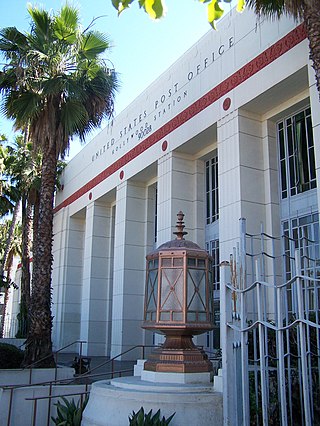
The United States Post Office in Hollywood, Los Angeles, California, also known as Hollywood Station, is an active U.S. post office located at 1615 Wilcox, between Sunset and Hollywood Boulevards. It is on the National Register of Historic Places.

Lincoln Heights Branch Library is the second oldest branch library in the Los Angeles Public Library system. Located in the Lincoln Heights section of Los Angeles, California, it was built in the Classical Revival and Italian Renaissance Revival styles in 1916 with a grant from Andrew Carnegie. One of three surviving Carnegie libraries in Los Angeles, it has been designated as a Historic-Cultural Monument and listed on the National Register of Historic Places.

Board of Trade Building is a historic building in Downtown Los Angeles that was opened in 1929. Located at the northwest corner of Main Street and Seventh Street, the building was designed by Claud Beelman and Alexander Curlett in the Beaux Arts style with Classical Revival influence. The building was listed in the National Register of Historic Places in 2008 and is one of more than ten Claud Beelman buildings included in the National Register.
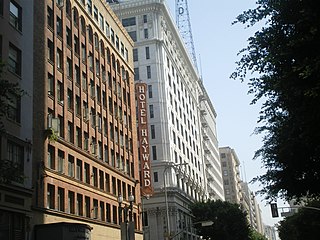
Spring Street in Los Angeles is one of the oldest streets in the city. Along Spring Street in Downtown Los Angeles, from just north of Fourth Street to just south of Seventh Street is the NRHP-listed Spring Street Financial District, nicknamed Wall Street of the West, lined with Beaux Arts buildings and currently experiencing gentrification. This section forms part of the Historic Core district of Downtown, together with portions of Hill, Broadway, Main and Los Angeles streets.
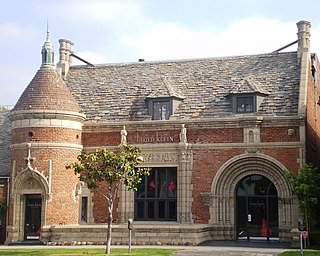
The Heinsbergen Decorating Company Building, also known as the AT Heinsbergen & Company Building, is a historic building on Beverly Boulevard in Los Angeles, California, United States. It was listed on the National Register of Historic Places in 1984.

The Delphi Hotel is a 12-story hotel located at 550 S Flower St in Downtown Los Angeles in the marble-clad high-rise Superior Oil Company Building formerly the headquarters of the now defunct company, converted to The Standard Downtown LA hotel in 2002, then closed in 2020 and reopened in 2023 under its current name.

William F. Curlett and Alexander Edward Curlett were a father-and-son pair of architects. They worked together as partners under the name of William Curlett and Son, Architects from c. 1908–1916. Aleck Curlett partnered with Claud Beelman as Curlett & Beelman (1919–1932).

The City Hall Park Historic District encompasses one of the central economic, civic, and public spaces of the city of Burlington, Vermont. Centered on City Hall Park, the area's architecture encapsulates the city's development from a frontier town to an urban commercial center. The district was listed on the National Register of Historic Places in 1983.

The Riverside Avenue Historic District is a 16.5 acres (6.7 ha) historic district in Downtown Spokane, Washington consisting of buildings constructed in the early 20th century, and was listed on the National Register of Historic Places in 1976. The listing includes 14 contributing properties, nine of which are considered primary and five are considered secondary.

7th Street is a street in Los Angeles, California running from S. Norton Ave in Mid-Wilshire through Downtown Los Angeles. It goes all the way to the eastern city limits at Indiana Ave., and the border between Boyle Heights, Los Angeles and East Los Angeles.

Hollywood Boulevard Commercial and Entertainment District consists of twelve blocks between the 6200 and 7000 blocks of Hollywood Boulevard in Los Angeles. This strip of commercial and retail businesses is recognized for its historical significance and was entered into the National Register of Historic Places in 1984.

The Okmulgee Downtown Historic District is the original downtown area of Okmulgee, Oklahoma, roughly bounded by 4th Street, 8th Street, Okmulgee Avenue, and the Frisco tracks. It was added to the National Register of Historic Places on December 17, 1992.






















